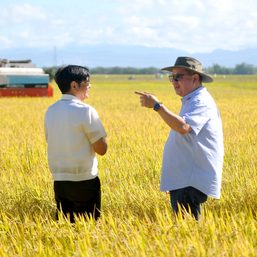SUMMARY
This is AI generated summarization, which may have errors. For context, always refer to the full article.

MANILA, Philippines – The Philippines has overtaken China as the world’s top importer of rice, according to a report from the United States Department of Agriculture (USDA).
In its report “Grain: World Markets and Trade” released on Tuesday, September 12, USDA projected that the Philippines will hit 3.8 million metric tons of rice imports for marketing year 2023-2024, as opposed to China’s decreased projection of 3.5 million MT. The USA also projected a lower global rice production until 2024.
Global rice prices increased due to stronger demand and lower production, the report said, even before India announced its export ban in July. India accounts for around 40% of the world trade, sending shockwaves across the globe when it imposed the ban.
The Philippines was primarily affected and is now seeking to augment supplies through Vietnam. Both governments are set to sign a pact on rice trade soon.
Some lawmakers have lamented the “reliance” of the Philippines’ Department of Agriculture on rice imports. Farmers’ group Kilusang Magbubukid ng Pilipinas (KMP) said importation only exacerbates the “chronic problems besetting the domestic rice industry.”
“The deluge of imported rice into the local market will never be an assurance of cheaper rice,” said KMP chairperson Danilo Ramos. “In the end, consumers will have to contend with perennially unaffordable and skyrocketing rice prices.”
Rice is a food staple in the Philippines, with rising prices affecting households across classes. The government imposed a temporary price cap on rice, while the Department of Finance is proposing lower tariffs.
Not like the 2008 crisis
In spite of the grim picture on rice supply, the USDA said the situation is not yet at the level of the 2008 rice crisis.
In 2008, the Philippines was the world’s top rice importer. At that time, several countries placed restrictions on their exports, driving up the price of rice.
“Despite the strong increase in export quotes, prices have not hit 2008 records for a few reasons,” the USDA said in the report.
The agency attributed this to Vietnam’s continuing exports and India’s exceptions to the ban allowing parboiled rice exports and small government-to-government trade.
In anticipation of the impact of El Niño, the DA had been eyeing increasing more imports until next year.
In August, Agriculture Undersecretary Mercedita Sombilla said the agency aas targeting to import 500,000 metric tons of rice from November 2023 to January 2024, in case El Niño peaks.
The EL Niño phenomenon would bring dry spells and is expected to affect food production and security in the country.
Meanwhile, rice prices are expected to go down soon as the wet season palay harvest starts. – Rappler.com
Add a comment
How does this make you feel?







![[ANALYSIS] How one company boosts farmer productivity inside the farm gate](https://www.rappler.com/tachyon/2024/06/bioprime-farmgate-farmer-productivity-boost.jpg?resize=257%2C257&crop=465px%2C0px%2C1080px%2C1080px)

There are no comments yet. Add your comment to start the conversation.